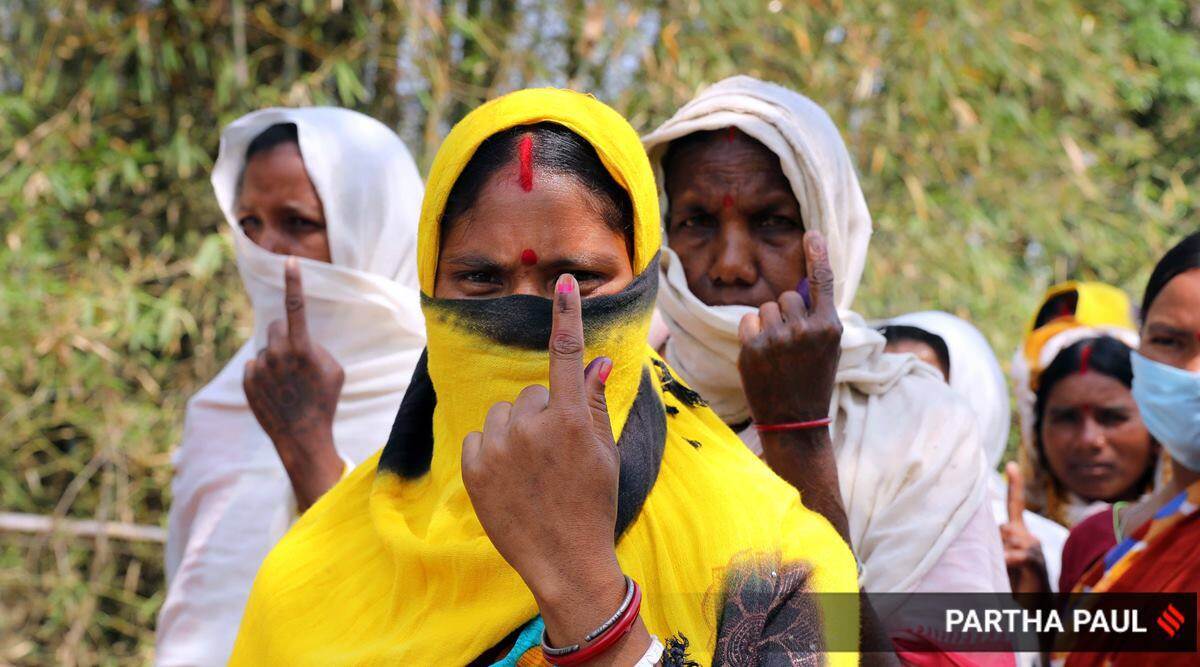 A voter showing ink mark after casting vote at Dhoska village in Purulia during the first phase of West Bengal Assembly elections. (Express photo by Partha Paul)
A voter showing ink mark after casting vote at Dhoska village in Purulia during the first phase of West Bengal Assembly elections. (Express photo by Partha Paul) The first phase of assembly elections in West Bengal is over. This time, the polls span over eight phases. The results will be declared on May 2. Most opinion polls suggest that Mamata Banerjee’s Trinamool Congress will be back to govern Bengal for another five years. The long-term trends of Assembly elections in the state show that the incumbent government does return to power if it has performed reasonably well, has a credible mass leader and a believable political narrative. Those who do psephology know that the opinion polls are relatively weaker than the exit polls.
Moreover, in both opinion and exit polls, the most challenging task for pollsters is to accurately project seats rather than the probability of parties getting the exact percentage of votes. In the recent past, political psephology as a specialised field in political science has evolved to correct past mistakes of analysing and calculating voting behaviour. Its methods are derivatives of empirical political science and rational choice theory, rooted in mainstream Western social sciences. However, in the last few years, it has been noticed that the election results in the West and South Asian countries have surprised psephologists. In West Bengal, too, this has happened before, not once but twice.
In the 2001 assembly elections, a section of the media suggested that the elections will be very close and that the then opposition leader Mamata Banerjee could even form the government. There was an undercurrent of anger against the then Left Front, and it was suggested that it would fall to an anti-incumbency wave. Left Front leaders, in contrast, poked fun at the mahajot (grand alliance) between the Trinamool and the Congress and insinuated that a bunch of conspirators had come together. They predicted a grand fiasco for the alliance. After the exit polls, Mamata Banerjee flashed a victory sign and even declared the cabinet’s probable members. The actual election results were quite the opposite of the exit polls. The Left Front returned to office with a two-thirds-majority and was, in fact, only four short of its 1996 tally.
In 2016, the exit poll results of a section of the Bengali media were wrong in terms of the margin of win. They had talked of a close fight between the ruling Trinamool and the Opposition Left-Congress alliance. The actual results were very different: The TMC came back to power with more than two-thirds majority of 211 seats. In 2001, it seems the TMC was misled by a section of the media. In 2016, the Left-Congress alliance met the same fate. What will the fate of the BJP be? Will it tally with the narrative set by the pre-election polls? We have about a month to wait for answers.
The long-term trends of assembly elections in West Bengal show that the BJP gets fewer votes in percentage terms compared to parliament elections. Let’s look at some figures of the past 12 years, when the independent strength of the Left has been dwindling. The BJP got 6.14 per cent votes in the 2009 Lok Sabha elections. But in the 2011 Vidhan Sabha elections, it got only 4.06 per cent votes. In the 2014 elections, it shot up to 17.02 per cent votes in the wake of a pro-Narendra Modi and an anti-Congress wave in the Lok Sabha election. The BJP’s vote share came down to 10.28 per cent in the 2016 Vidhan Sabha elections. In 2019, the party surprised many pollsters and political pundits when its vote share touched 40.25 per cent.
The performance of the BJP in the 2019 elections was due to three factors. First, there was anger against the TMC for poll violence in the 2018 panchayat elections in the state. Second, there seemed to be no credible alternative against the Narendra Modi-led BJP in a national election. At the state and central level, the Opposition parties were divided between the regional forces, the Congress-led UPA and the Left Front. In fact, in Bengal, there was no alliance between the Left and the Congress. As a result, the anti-Trinamool vote got consolidated behind the BJP. Finally, the election was grounded on the RSS’s core issues, and emotions — around the Ram Mandir, CAA-NRC, abrogation of Article 370, and issues of national security and terrorism following the Pulwama attack — were whipped up.
In the 2016 assembly elections, the state’s Opposition leader had said that the Left-Congress alliance would get 200 seats. It ended up with just 77. In the run-up to the current elections, the Union home minister of India has said that the BJP will win 200 seats. This has been contested by the strategist Prashant Kishore, who has asserted that the BJP will not touch even 100 seats.
Ground reports by journalists and field investigation by this writer show that BJP candidates are being asked difficult questions on issues of inflation and increased prices of petrol-diesel and gas cylinders. The TMC leaders are also being confronted with allegations of corruption. In other words, the anti-TMC space is being contested between the BJP and the grand alliance of the United Front. The stakes are pretty high for Team PK, Trinamool and the BJP.
The writer is assistant professor of political science at the Centre for Studies in Social Sciences, Kolkata
- The Indian Express website has been rated GREEN for its credibility and trustworthiness by Newsguard, a global service that rates news sources for their journalistic standards.

